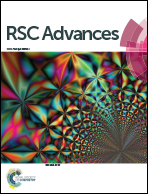All near-infrared multiparametric luminescence thermometry using Er3+, Yb3+-doped YAG nanoparticles†
Abstract
This paper presents four new temperature readout approaches to luminescence nanothermometry in spectral regions of biological transparency demonstrated on Yb3+/Er3+-doped yttrium aluminum garnet nanoparticles. Under the 10 638 cm−1 excitation, down-shifting near infrared emissions (>10 000 cm−1) are identified as those originating from Yb3+ ions' 2F5/2 → 2F7/2 (∼9709 cm−1) and Er3+ ions' 4I13/2 → 4I15/2 (∼6494 cm−1) electronic transitions and used for 4 conceptually different luminescence thermometry approaches. Observed variations in luminescence parameters with temperature offered an exceptional base for studying multiparametric temperature readouts. These include the temperature-dependence of: (i) intensity ratio between emissions from Stark components of Er3+ 4I13/2 level; (ii) intensity ratio between emissions of Yb3+ (2F5/2 → 2F7/2 transition) and Er3+ (4I13/2 → 4I15/2 transition); (iii) band shift and bandwidth and (iv) lifetime of the Yb3+ emission (2F5/2 → 2F7/2 transition) with maximal sensitivities of 1% K−1, 0.8% K−1, 0.09 cm−1 K−1, 0.46% K−1 and 0.86% K−1, respectively. The multimodal temperature readout provided by this material enables its application in different luminescence thermometry setups as well as improved the reliability of the temperature sensing by the cross-validation between measurements.

- This article is part of the themed collection: Shining a Light on the f-Block


 Please wait while we load your content...
Please wait while we load your content...